Our aim with The Day by day Temporary is to simplify the most important tales within the Indian markets and enable you perceive what they imply. We received’t simply inform you what occurred, however why and the way too. We do that present in each codecs: video and audio. This piece curates the tales that we discuss.
You may take heed to the podcast on Spotify, Apple Podcasts, or wherever you get your podcasts and watch the movies on YouTube. You can even watch The Day by day Temporary in Hindi.
In in the present day’s version of The Day by day Temporary:
We’re gridlocked on grids
RBI’s Daring Transfer
A few of the world’s greatest investments, in the present day, are in power.
A brand new report from the Worldwide Vitality Company (IEA) exhibits that by 2025, we’ll spend $3.3 trillion on power — and $2.2 trillion of that’s going towards clear applied sciences, like photo voltaic panels, wind generators and electrical vehicles. That’s twice as a lot as we’re spending on oil, fuel, and coal mixed.
To the IEA, we’re moving into one thing known as the “Age of Electrical energy “.
We’ve beforehand spoken about how the power sector is primarily cut up into two sectors — oil and pure fuel, and electrical energy. Final week, we went deeper into the primary phase. Right now, we’re trying on the different aspect. The electrical energy phase is every thing from making electrical energy to bringing it to your private home — energy crops, photo voltaic farms, buying and selling platforms, energy strains, and different issues that make up “the grid ”.
Simply ten years in the past, we have been spending far more cash on fossil fuels than on electrical energy. Right now, these numbers have flipped. We’re now investing $1.5 trillion within the electrical energy sector alone, which is 50% greater than what we spend on all fossil fuels put collectively.
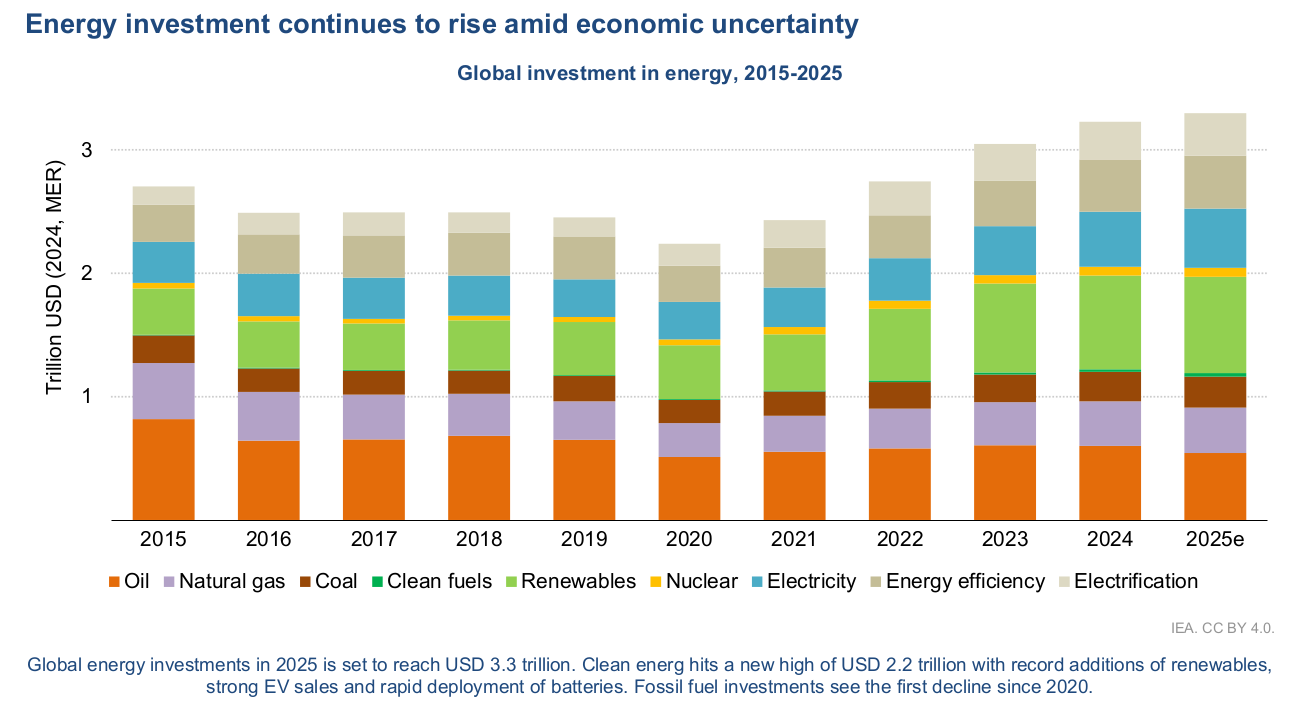
Supply
This isn’t only a local weather change story — though it’s that as properly. Nations do need cleaner power, however greater than that, they’re additionally pushed by power safety issues.
As an example, China, similar to us, is dependent upon imports for many of its oil. That’s a important vulnerability: if its oil imports are blocked, the nation may come to a standstill. It plans to cut back this dependence, which is why it’s main world clear power funding — funneling $630 billion into the sector in 2025. Equally, Europe desires to be much less reliant on Russian fuel, particularly after Russia began utilizing it as some extent of leverage over the continent. And everybody desires to get forward within the booming synthetic intelligence financial system, creating large demand for electrical energy to run all the information facilities.
The numbers present simply how dramatic this shift is. Solar energy alone is predicted to draw $450 billion in funding in 2025, making it “the biggest single merchandise in our stock of the world’s funding spending ” in response to the IEA. That’s more cash than some other single power know-how in historical past. All this whereas, upstream oil funding is about to fall by 6% in 2025 — the primary year-on-year decline because the COVID-19 hunch in 2020.
However is that sufficient to result in an “age of electrical energy”? Not fairly. As a result of elements of this transition are nonetheless severely underfunded. That’s what we’re , in the present day.
The Lacking Hyperlink
Whereas we’re constructing photo voltaic farms and wind generators at breakneck pace, we’ve maybe uncared for all of the much less fancy however essential infrastructure that truly takes their electrical energy to the place it’s wanted: the ability grid .
Consider the grid like a freeway system, however for electrical energy. It’s a large community of energy strains, substations, and transformers that carry electrical energy from energy crops to your private home. Once you flip a light-weight change, that electrical energy that flows to your lights might need traveled a whole bunch of kilometers by this freeway system to succeed in you.
We have to do extra to construct out these electrical highways.
IEA isn’t speaking about this for the primary time. Again in 2023, the IEA estimated we have to add or rebuild 80 million kilometers of energy strains by 2040 — basically doubling the complete world grid. It was blunt concerning the penalties: with out large grid funding, we’d be in a “Grid Delay Case ” — the place we will’t carry the clear electrical energy we’re making to the individuals who want it. That’ll set us again within the inexperienced transmission, including 58 billion further tons of CO2 emissions by 2050 — equal to 4 years’ price of present world energy sector emissions — despite the fact that we have now the means to keep away from it.
If we need to get round this, we’d like lots, and we imply lots, of funding on this sector. Some estimates say we would require $3.1 trillion in investments by 2030 within the grid alone to restrict world warming to 1.8°C.
Are we shut? In no way.
In the meantime, world grid funding has barely budged. We’ve been placing in round $300 billion per 12 months since 2015, even whereas renewable funding has almost doubled. Solely now’s this beginning to climb. Grid funding reached a brand new excessive of $390 billion globally in 2024 and is about to surpass that to USD 400 billion for the primary time this 12 months. That’s encouraging, nevertheless it’s nowhere close to what’s wanted.
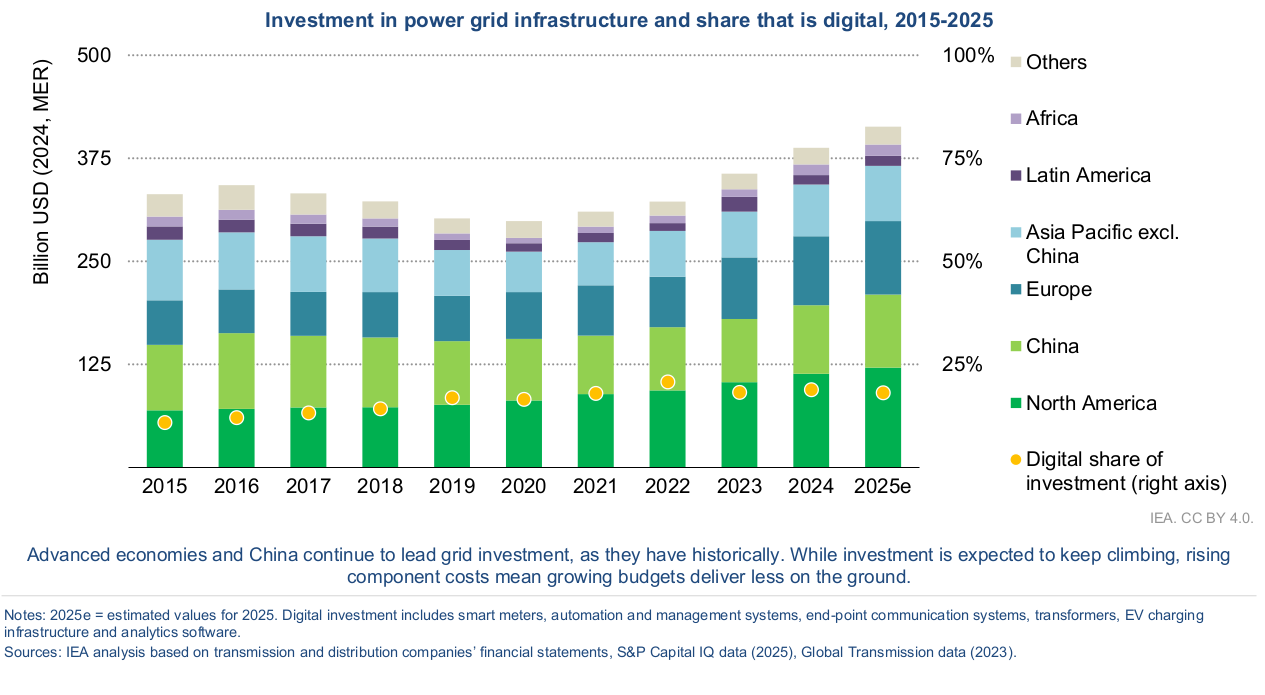
Supply
Right here’s one mind-set concerning the lag in our grid investments: again in 2016, for each greenback spent on constructing new energy crops, we invested 60 cents within the grid. Right now, that has dropped to lower than 40 cents. We’re constructing tons of latest electrical energy era however not almost sufficient infrastructure to really ship it.
What occurs if you don’t spend sufficient on a freeway system? Horrible site visitors jams throughout.
That’s what occurs if you don’t construct this electrical freeway system as properly. Proper now, there are 1,650 GW of photo voltaic and wind tasks — six occasions the complete electrical energy capability of an industrial powerhouse like Germany — simply sitting round and ready to be related to the grid. These tasks are constructed and so they’re able to go . They may carry us electrical energy in the present day , however they’ll’t as a result of the grid infrastructure isn’t there.
Why transmission is a particular problem for inexperienced power
You may surprise why there’s such a grid scarcity — in spite of everything, it’s not like we haven’t transmitted electrical energy earlier than. We’ve constructed out infrastructure for thermal energy already, haven’t we? However right here’s the factor about renewable power: it wants the grid far more than conventional energy crops do.
A coal or fuel plant could be constructed just about anyplace and runs 24/7. All you want is a stockpile of gasoline. Then again, inexperienced energy crops need to be constructed the place power is essentially the most plentiful. Photo voltaic farms should be constructed the place it’s sunny, and wind farms the place it’s windy. And that may properly be in some distant space, far-off from cities. And so, you want numerous new transmission strains to hold that energy to the place individuals truly dwell and work.
After which, there’s the intermittency downside: the solar doesn’t all the time shine and the wind doesn’t all the time blow. In order for you some stability, you should diversify . You want a grid that runs throughout huge distances, balancing provide and demand points throughout areas. When it’s calm and cloudy in a single place, the grid must shortly pull energy from some other place the place situations are higher. That’s one among our greatest methods of managing fluctuations in renewable power manufacturing.
Constructing the grid is tough work
This looks as if a reasonably apparent downside, proper? If our under-investment in grids is definitely hurting the clear power investments that we’re making, why isn’t this getting extra consideration.
One easy reply is that it’s simply onerous to construct the grid.
Take the time comparability. A brand new photo voltaic farm is a comparatively easy, localised venture. You may construct one in round 1-5 years. Then again, for those who’re constructing a whole bunch of kilometers price of transmission infrastructure reducing throughout large swathes of land, it’ll take for much longer. You want in depth planning to drag it off. You must get a spread of approvals and permits in place. You must purchase giant quantities of land. You must work out the way to work by all kinds of inauspicious terrain. And on high of that, you possibly can encounter all kinds of surprising hurdles. For instance, in Rajasthan, many transmission tasks have been held up as a result of they have been reducing by the habitat of the Nice Indian Bustard. Not one thing you may plan for, proper?
Including on to the problem, in India, completely different elements of the federal government are chargeable for establishing energy crops and establishing transmission strains. Co-ordination between the 2 is usually reasonably poor, resulting in extreme mismatches between a area’s capability to generate energy, and to make it obtainable for individuals elsewhere.
All of those issues imply that on common, creating new grid infrastructure anyplace between 5 and 15 years. That’s a elementary timing mismatch, that results in years of delay.
The one possible way out of the timing mismatch is to plan your grid out forward of time, earlier than all of the renewables tasks come up. However in India, at the least, our system is about as much as penalise such planning. After a latest modification, if a transmission firm builds an influence line however no electrical energy flows by it initially, they solely get a fraction of their regular cost for the primary six months. That actively disincentivises them from planning forward. Since transmission firms by no means know precisely when permitted power tasks will truly begin working, they often keep away from constructing the required infrastructure early. Why danger finishing a venture on time for those who may get penalized with lowered funds whereas ready for different tasks to catch up?
On high of all that, it’s onerous to seek out all of the tools we’d like for our grids.
As an example, we’re at present going by a world-wide scarcity of transformers, that’s holding up energy tasks everywhere in the world. In case you place an order for transformers proper now, it will probably take as much as 4 years to ship. Issues like this reveal simply how unprepared the world was for the pace of the power transition. Transformers enable us to securely and effectively transfer energy over lengthy distances and ship it to properties and companies. They’re elementary to constructing a grid. And but, the world’s provide merely can’t sustain with the explosive demand.
This downside received’t be solved in a single day. The worldwide transformer market — price $13.5 billion in 2023 — is dominated by a handful of nations. China, South Korea, Turkey, and Italy account for half of all transformer exports, making the complete world depending on just some key suppliers. And ramping up provide is tough. Even the uncooked supplies wanted for transformers – copper, aluminum, uncommon earths, and specialised electrical metal — are all getting costlier and more durable to supply, for causes starting from a scarcity of provide of supplies, to geopolitical tensions, to tariffs, to uncommon earth export bans, and extra. The consequences of this provide chain stress ripple in all places. Transformer costs have gone by the roof — costing 75% greater than they did as lately as 2018.
That’s only one downside. We’re working into many different such shortages. Cable orders that used to take a number of months now require two to 3 years of ready, and have almost doubled in worth since 2018. Some specialised tools has wait occasions exceeding 5 years .
So as to add insult to damage, the business additionally faces a talented employee scarcity. Presently, about 8 million individuals work in grid development and upkeep worldwide, however the IEA says we have to add one other 1.5 million employees by 2030 simply to fulfill primary coverage targets.
The outcomes are clear. A short time in the past, Enterprise Customary reported that right here, in India, roughly 40 transmission tasks price 60 GW of renewable power didn’t but have connectivity approval from the Central Transmission Utility, which implies they too aren’t related to the grid but. We’re attempting to spend our manner round our bottlenecks — the Inexperienced Vitality Hall scheme, as an example, goals to speculate $2.6 billion in India’s transmission community. However who is aware of if it’ll be taken to fruition.
However this isn’t only a downside for our nation — it’s a world disaster. In Europe, some renewable power tasks are ready as much as 9 years simply to get permission to connect with the grid. In the USA, the backlog of tasks ready for grid connections has grown eight occasions bigger than it was a decade in the past.
Batteries
One know-how that’s supposed to assist remedy the renewable power puzzle, as we mentioned a number of days in the past, is battery storage. Funding into this house is booming. The IEA studies that world battery storage funding is about to succeed in $66 billion in 2025.
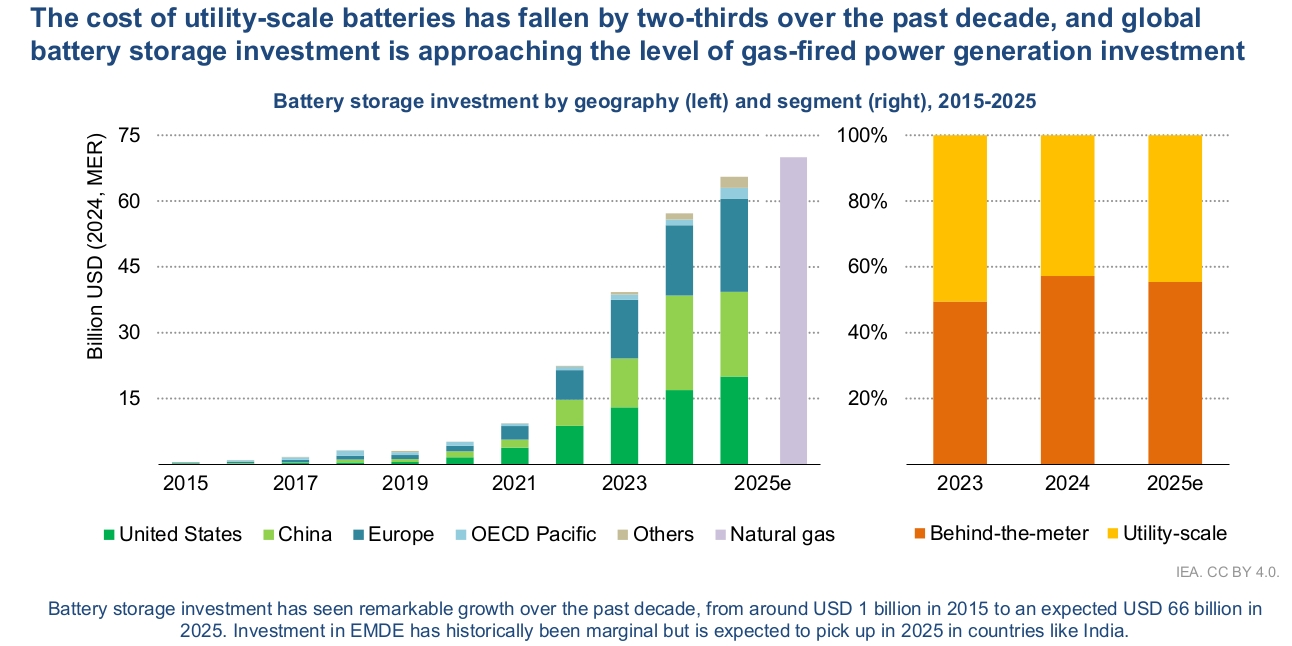
Supply
Consider batteries because the grid’s manner of coping with the truth that electrical energy demand and renewable power provide not often match up completely. If electrical energy demand and provide is just matched in real-time, you’re clearly going to run into issues. These large battery methods act like large shock absorbers for the grid, absorbing extra solar energy when the solar is blazing and releasing it again when clouds roll in.
In California, for instance, a lot solar energy will get generated throughout sunny afternoons that electrical energy costs generally go unfavourable. We lately noticed costs virtually contact zero in India too. Batteries can retailer that extra energy and launch it when it’s wanted.
However right here’s the catch: these batteries face precisely the identical grid connection issues as every thing else. You may construct a billion-dollar battery storage facility in a 12 months, however for those who can’t get the transformers and transmission strains to attach it to the grid, it’s mainly ineffective. The batteries themselves may be getting cheaper and extra environment friendly, however they nonetheless want all that primary grid infrastructure to really perform.
Bottomline
We’ve lately made large progress with our inexperienced power build-out. Whereas local weather change isn’t an issue we will escape, we’re lastly attempting to step as much as the problem.
But when we don’t repair our grid downside, all these photo voltaic panels and wind generators we’re constructing received’t matter. The clear power transition may stall, not as a result of we lack the know-how, however as a result of we couldn’t construct a system to ship it.
The power transition is usually considered an influence era problem — how can we kick off from fossil fuels and construct sufficient renewable capability. However the actual constraint has develop into the mundane however important infrastructure that truly delivers electrical energy. Within the Age of Electrical energy, this infrastructure is the very basis that every thing else is dependent upon.
The Reserve Financial institution of India simply delivered a double whammy that caught everybody off guard — a hefty 50 foundation level fee minimize when markets have been anticipating simply 25, and a large 100 foundation level discount within the Money Reserve Ratio.
That is essentially the most dovish we’ve seen the RBI be in years . However on the identical time, in addition they shifted their stance to impartial, basically slamming the brakes on easing for now.
Confused? Don’t fear, we’ll enable you make sense of all of it.
The Shock Package deal
Let’s begin with what occurred yesterday on the RBI’s fifty fifth Financial Coverage Committee assembly.
Governor Sanjay Malhotra and his crew delivered what can solely be described as a shock-and-awe technique. First, the repo fee — the speed at which banks borrow from the RBI — was slashed by 50 foundation factors to five.5%. A foundation level is one-hundredth of a proportion level, so we’re speaking a couple of half a p.c shaved off rates of interest. Most analysts, then again, have been betting on simply 25 foundation factors.

Historic Repo Charge
That wasn’t all. The RBI additionally introduced a 100 foundation level minimize to the ‘Money Reserve Ratio’, or CRR. That’s basically the share of their deposits that banks should park with the RBI as a security buffer. It’s cash that banks technically possess, however can’t lend out. This can now come down from 4% to three% over 4 phases, beginning September. That might inject a large 2.5 lakh crore rupees into the banking system by December.
When banks have more cash to lend, it’s simpler for them to supply loans at cheaper charges. It’s like having extra stock in a store — you may afford to be extra aggressive along with your pricing.
However simply as markets have been getting enthusiastic about this dovish stance, the RBI pulled a basic central financial institution transfer — they modified their coverage stance from “accommodative” to “impartial.” These are extra than simply fancy phrases; they inform you how the RBI may transfer sooner or later. When a central financial institution adopts an “accommodative” stance, it’s basically signaling that it’s in a temper to assist the financial system — and can minimize charges additional if wanted. Consider it as a inexperienced gentle for extra easing.
A “impartial” stance, then again, means the central financial institution is taking a wait-and-watch strategy. It desires to look at the financial system for now, and react to no matter occurs. It may go both manner for now — minimize charges if issues worsen, or increase them if inflation picks up.
Governor Malhotra was fairly clear about what this shift means:
“…financial coverage now has “very restricted house to help progress.” “
In different phrases, don’t anticipate many extra fee cuts.
Balancing inflation and progress
So why did the RBI make all these strikes? All of it comes right down to the basic central financial institution dilemma — balancing progress and inflation.
On the inflation entrance, issues are trying remarkably good for India proper now. Client worth inflation has dropped to a virtually six-year low of three.2% in April — properly under the RBI’s goal of 4%. Meals inflation, which was a large and protracted headache, recorded its sixth consecutive month-to-month decline.
The RBI is so assured about our present inflation trajectory that they’ve revised their forecast downward from 4% to three.7% for the complete monetary 12 months. They’re even projecting that inflation may undershoot their goal — one thing that may have been unthinkable only a 12 months in the past, when it appeared inconceivable to maintain inflation beneath its higher tolerance band.
What’s driving this benign inflation outlook? A number of components are at play. We’ve had file wheat manufacturing, good monsoon forecasts, and world commodity costs are anticipated to stay gentle. Even rural households — who’re sometimes extra delicate to meals worth adjustments — are exhibiting moderating inflation expectations.
Until we see a extreme shock to our financial system, it appears like costs will stay secure for a while.
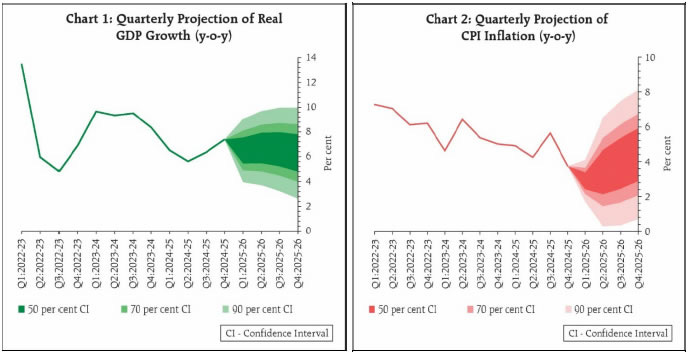
Supply
However there’s one other aspect to the coin — progress .
That’s the place issues are considerably extra worrying. India’s GDP grew at 6.5% final 12 months. That sounds spectacular, and in comparison with a lot of the world, it’s. However it’s properly under our nation’s potential, in addition to what we’d like. The federal government and RBI need to see progress nearer to 7-8% yearly to create sufficient jobs for India’s younger, and sometimes unemployed, inhabitants.
International headwinds are making issues even worse. We’re seeing commerce tensions, geopolitical uncertainties, and a common slowdown in world progress — that are all weighing on India’s export prospects. The world isn’t an ideal market, and so, home demand has develop into essential. That’s precisely what the RBI is attempting to stimulate with these fee cuts.
What are the specialists saying?
To get a deeper perspective on these strikes, let’s take a look at some skilled commentary.
Suyash Choudhary, Head of Mounted Earnings at Bandhan AMC, has some fascinating insights. He factors out one thing essential that many missed within the preliminary pleasure –- whereas the RBI gave lots with the aggressive fee minimize and CRR discount, in addition they took one thing away by shifting to a impartial stance so shortly.
His key statement is about what he calls the “expectation channel .” Right here’s what he means: financial coverage doesn’t simply work by present rates of interest , but additionally by what individuals anticipate charges to be sooner or later . Markets all the time take bets on the longer term. If a enterprise is contemplating whether or not to take a mortgage with floating rates of interest, it doesn’t simply take a look at in the present day’s rates of interest, but additionally how they could go tomorrow. If companies and customers suppose charges will fall additional, they may be extra keen to borrow and make investments in the present day .
However by declaring that financial coverage has “restricted house” and shifting to impartial, the RBI basically capped these expectations. As Choudhary places it, this forces “the bar increased in market’s thoughts” and works considerably counter to the general goal of transmission. To the market, it virtually seems like that that is nearly as good as issues are going to get. And that isn’t fairly as compelling.
This shift in expectations performed out completely out there’s quick response. We noticed aggressive curve steepening — that’s market jargon for short-term charges falling greater than long-term charges. Folks don’t anticipate cash to get any cheaper sooner or later, in order that they demand extra to lend their cash out for longer. Basically, merchants began pricing out any future fee cuts.
Choudhary additionally questions the timing of the stance change. He argues that with world financial uncertainties nonetheless unfolding, an accommodative stance might need been the smarter factor to do. In any case, we haven’t but seen the complete affect of world tensions on precise financial information — and if issues take a flip for the more severe, you don’t need the market to panic that no extra help is coming.
How do the speed cuts work?
A lot of our listeners surprise how these RBI fee cuts truly attain you and me? How can the RBI, simply by tweaking some numbers round, change the very path of our financial system?
The method known as “financial coverage transmission ”, and it’s extra advanced than you may suppose. The RBI’s latest annual report provides us some fascinating insights into this course of. Allow us to stroll you thru the way it works.
When the RBI cuts the repo fee, it doesn’t robotically imply your private home mortgage EMI drops the following day. The speed minimize has to journey all over the banking system.
This journey isn’t all the time clean or fast. Right here’s the way it goes: first , the repo fee minimize impacts cash market charges — the place banks lend to one another to make up for momentary shortfalls. It tells banks a worth that RBI is keen to lend at. When banks lend to one another, they take that as a base fee. As a result of the market’s charges are the charges at which banks themselves get cash, it’s form of the minimal worth of cash within the nation. When there’s numerous liquidity within the system, this fee is way under the RBI’s repo fee. And that’s what we’ve seen — the “weighted common name fee”, which gauges the borrowing price for banks, has buying and selling under the repo fee for some time.
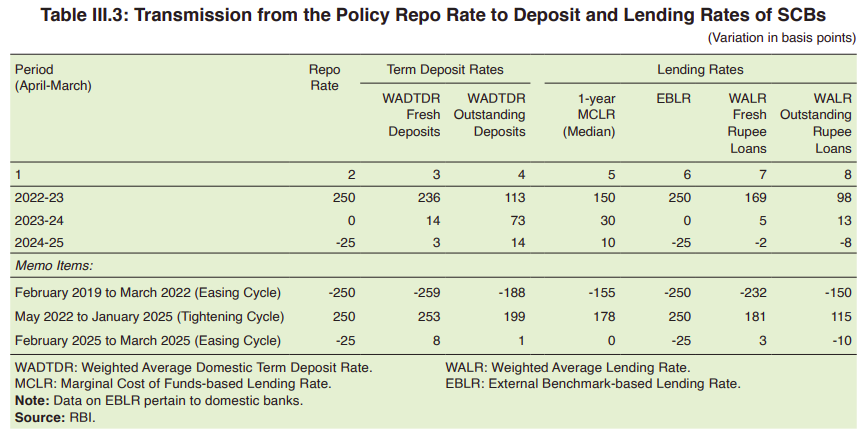
Supply
Subsequent, banks want to regulate their very own lending charges. However not all loans are priced the identical manner. For various kinds of loans, the pace at which they present up for debtors is completely different.
RBI’s information exhibits that about 60% of financial institution loans at the moment are straight linked to exterior benchmarks just like the repo fee. For these loans, known as EBLR loans, the transfer is immediate. Loans reprice virtually instantly when the RBI cuts charges.
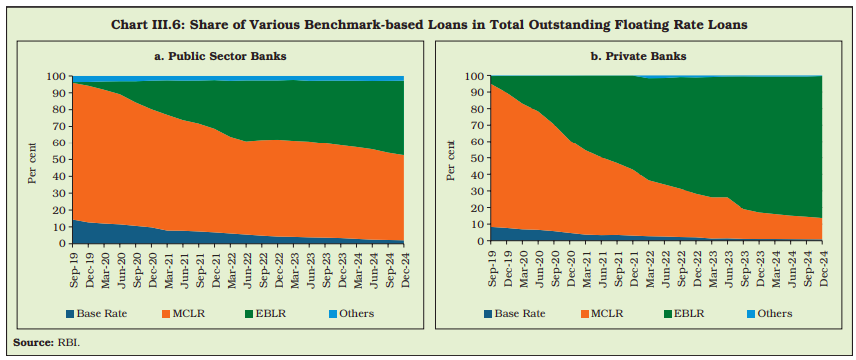
Supply
However the remaining 40% are nonetheless linked to older benchmarks — just like the ‘Marginal Value of Funds-based Lending Charge’, or MCLR. These alter extra slowly. They’re primarily based on the financial institution’s price of funds, which adjustments regularly as all their deposits get repriced.
The annual report reveals some fascinating variations between financial institution varieties. Non-public banks have about 86% of their loans linked to exterior benchmarks. Public sector banks, then again, lag at simply 45%. This implies personal financial institution prospects see quicker transmission of fee cuts.
This additionally adjustments by sector. Housing loans, that are principally linked to exterior benchmarks, see fast transmission. However company loans and another segments nonetheless depend upon MCLR and take longer to regulate.
The transmission works otherwise to your deposits. Time period deposit charges have already began falling, with some banks reducing charges by 40-50 foundation factors. However this makes its manner by the system regularly, as outdated deposits mature and get renewed at new charges.
What about CRR?
Now, let’s discuss concerning the CRR minimize, which is an enormous deal — particularly for financial institution income, and what’s known as their ‘Internet Curiosity Margins’, or NIMs.
To start with, right here’s what NIMs are: they’re basically the distinction between what banks earn on loans and what they pay on deposits. It’s the core measure of financial institution profitability. It’s to a financial institution what a mark-up is to your native kirana retailer — the larger the distinction between shopping for and promoting worth, the higher the revenue.
Banks need to park cash with the RBI in response to what the CRR is. They don’t earn any curiosity on this cash. To them, it’s basically useless capital. So when the RBI cuts CRR, to banks, it’s like an asset that was doing nothing can immediately develop into productive. And the dimensions of the minimize signifies that immediately, 1% of the banking system’s deposits have come alive.
In line with Citi Analysis evaluation, this 100 foundation level CRR minimize may add 6-8 foundation factors to financial institution Internet Curiosity Margins. Banks which have low margins in the present day — primarily public sector and overseas banks — will immediately discover much more room to breathe.
And take a look at the timing! Citi’s evaluation means that financial institution NIMs, particularly for personal banks, have been anticipated to hit the underside within the second quarter of this fiscal 12 months. Between the speed cuts and this CRR discount, banks’ margins may stabilise far prior to one hoped. In line with Citi, personal banks have been slated to face a harder compression of their NIMs — probably 30-40 foundation factors within the second quarter — in comparison with public sector banks, at 20-25 foundation factors. The minimize provides them a cushion to fall on.
The cuts will occur in phases, from September by November. That coincides with the pageant season, when credit score demand sometimes picks up. This can make sure that banks have ample liquidity precisely after they want it most.
There’s one other angle right here. Keep in mind, banks have been struggling to develop their deposits recently. This minimize additionally provides them respiration room — it boosts how a lot of their deposits they’ll lend, in order that they don’t need to chase costly deposits.
So, the place does this go away us?
The RBI has basically front-loaded its financial easing. It has given the financial system a major increase upfront, reasonably than spreading it over a number of coverage conferences.
The problem, now, is transmission. Regardless of all these measures, lending charges haven’t fallen as a lot as the dimensions of the speed cuts would counsel. The RBI acknowledges this. That is the place the expectation channel that Suyash Choudhary talked about turns into essential. By shifting to impartial, the RBI might need inadvertently slowed the very transmission they’re attempting to speed up.
The market shall be watching inflation information intently. If inflation stays benign and world headwinds intensify, there may nonetheless be room for yet one more fee minimize regardless of the impartial stance. However for now, the RBI appears content material to attend and watch how these measures play out.
RBI Cuts CRR and Repo Charge, Injects ₹2.5 Lakh Crore Into Banking System
Supply: Reuters
In a bid to spice up credit score and improve coverage transmission, the Reserve Financial institution of India has introduced a 100 foundation level discount within the Money Reserve Ratio (CRR), bringing it down to three%. The minimize shall be carried out in 4 equal tranches between September and November 2025, unlocking ₹2.5 lakh crore in banking system liquidity. Alongside this, the Financial Coverage Committee lowered the repo fee by 50 foundation factors to five.5%, marking the third fee minimize of the 12 months and totaling a 100 foundation level discount in 2025. These strikes intention to cut back the price of funds and spur lending exercise. Financial institution shares reacted positively to the announcement. Markets are expecting indicators of improved credit score offtake and sectoral revival within the months forward.
Tata Superior Techniques to Manufacture Rafale Fuselages in Hyderabad Below Dassault Deal
Supply: Bloomberg
Tata Superior Techniques Ltd (TASL) has signed a producing settlement with Dassault Aviation to supply main airframe assemblies for Rafale fighter jets in Hyderabad. The ability will manufacture parts, together with the entrance part, central fuselage, rear part, and lateral rear fuselage shells. This marks the primary time full Rafale fuselages shall be constructed outdoors France. Manufacturing is predicted to start by FY2028, with a focused output of two full fuselages per 30 days. This transfer expands TASL’s aerospace footprint and integrates it additional into Dassault’s world provide chain. It additionally aligns with India’s broader protection manufacturing agenda, although particular monetary particulars of the deal haven’t been disclosed
Silver Hits Report ₹1.04 Lakh/kg, Surges 21.7% YTD
Supply: Financial Occasions
Silver costs in Delhi reached an all-time excessive of ₹1,04,100 per kilogram on June 5, persevering with their upward run for the fourth consecutive session. The Multi Commodity Change (MCX) additionally noticed silver futures for July supply hitting a file ₹1,05,213/kg, marking a powerful intraday rally of ₹3,833 or 3.78%. 12 months-to-date, silver has surged by 21.7%, rising from ₹86,017/kg on December 31, 2024, to ₹104,675/kg. The earlier all-time excessive was ₹1,03,500/kg on March 19. In world markets, silver crossed the $35/ouncesmark for the primary time since 2012, whereas spot gold stood at $3,395.29/oz. Domestically, gold of 99.9% purity rose ₹430 to ₹99,690 per 10 grams. Analysts attribute silver’s power to sturdy industrial demand, provide constraints, and inflation-hedging curiosity.

This version of the publication was written by Prerana and Kashish.
 Be part of our guide membership
Be part of our guide membership
We’ve began a guide membership the place we meet every week in JP Nagar, Bangalore to learn and discuss books we discover fascinating.
In case you suppose you’d be severe about this and wish to be part of us, we’d like to have you ever alongside! Take part right here.
 Have you ever checked out The Chatter?
Have you ever checked out The Chatter?
Each week we take heed to the massive Indian earnings calls—Reliance, HDFC Financial institution, even the smaller logistics corporations—and duplicate the complete transcripts. Then we bin the fluff and preserve solely the sentences that would transfer a share worth: a shock worth hike, a cut-back on manufacturing unit spending, a warning about weak monsoon gross sales, a touch from administration on RBI liquidity. We add a fast, one-line explainer and a timestamp so you may hint the quote again to the decision. The entire thing lands in your inbox as one sharp web page of info you may learn in three minutes—no 40-page decks, no jargon, simply the onerous stuff that issues to your trades and your macro view.
Go try The Chatter right here.
“What the hell is occurring?”
We’ve been pondering lots about the way to make sense of a world that feels more and more unhinged – the place every thing appears to be taking place directly and our ordinary frameworks for understanding actuality really feel fully insufficient. This week, we dove deep into three large shifts reshaping our world, utilizing what historian Adam Tooze calls “polycrisis” pondering to attach the dots.
Frames for a Fractured Actuality – We’re struggling to grasp the current not from ignorance, however from poverty of frames – the psychological shortcuts we use to make sense of chaos. Historian Adam Tooze’s “polycrisis” idea captures our second of a number of interlocking crises higher than conventional analytical frameworks.
The Hidden Monetary System – A $113 trillion FX swap market operates off-balance-sheet, creating systemic dangers regulators barely perceive. Foreign money hedging by world insurers has essentially modified how monetary crises unfold worldwide.
AI and Human Id – We’re going through humanity’s most profound id disaster as AI matches our cognitive talents. Utilizing “disruption by default” as a body, we assume AI reshapes every thing reasonably than dwelling in denial about job displacement that’s already taking place.
 What the hell is occurring?Frames for an unhinged momentHello, my identify is Bhuvan, and thanks for studying What the hell is occurring…Learn more8 days in the past · 4 likes · 2 feedback · Zerodha
What the hell is occurring?Frames for an unhinged momentHello, my identify is Bhuvan, and thanks for studying What the hell is occurring…Learn more8 days in the past · 4 likes · 2 feedback · Zerodha
Subscribe to Aftermarket Report, a publication the place we do a fast every day wrap-up of what occurred within the markets—each in India and globally.
Thanks for studying. Do share this with your pals and make them as good as you’re ![]()





